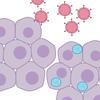Nisha Singh, Agustin Rolandelli, Anya J O’Neal, Rainer L. Butler, Sourabh Samaddar, Hanna J Laukaitis-Yousey, Matthew Butnaru, Stephanie E Mohr, Norbert Perrimon, and Joao HF Pedra. 9/8/2023. “Genetic manipulation of an Ixodes scapularis cell line.” bioRxiv, Pp. 9/8/2023. 09.08.556855. Publisher's VersionAbstract
Although genetic manipulation is one of the hallmarks in model organisms, its applicability to non-model species has remained difficult due to our limited understanding of their fundamental biology. For instance, manipulation of a cell line originated from the blacklegged tick Ixodes scapularis, an arthropod that serves as a vector of several human pathogens, has yet to be established. Here, we demonstrate the successful genetic modification of the commonly used tick ISE6 line through ectopic expression and clustered regularly interspaced palindromic repeats (CRISPR)/CRISPR-associated protein 9 (Cas9) genome editing. We performed ectopic expression using nucleofection and attained CRISPR-Cas9 editing via homology dependent recombination. Targeting the E3 ubiquitin ligase X-linked inhibitor of apoptosis (xiap) and its substrate p47 led to alteration in molecular signaling within the immune deficiency (IMD) network and increased infection of the rickettsial agent Anaplasma phagocytophilum in I. scapularis ISE6 cells. Collectively, our findings complement techniques for genetic engineering of ticks in vivo and aid in circumventing the long-life cycle of I. scapularis, of which limits efficient and scalable molecular genetic screens.Importance Genetic engineering in arachnids has lagged compared to insects, largely because of substantial differences in their biology. This study unveils the implementation of ectopic expression and CRISPR-Cas9 gene editing in a tick cell line. We introduced fluorescently tagged proteins in ISE6 cells and edited its genome via homology dependent recombination. We ablated the expression of xiap and p47, two signaling molecules present in the immune deficiency (IMD) pathway of I. scapularis. Impairment of the tick IMD pathway, an analogous network of the tumor necrosis factor receptor in mammals, led to enhanced infection of the rickettsial agent A. phagocytophilum. Altogether, our findings provide a critical technical resource to the scientific community to enable a deeper understanding of biological circuits in the blacklegged tick Ixodes scapularis.Competing Interest StatementThe authors have declared no competing interest.

